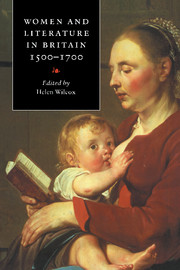Book contents
- Frontmatter
- Contents
- List of contributors
- Acknowledgements
- A note on references
- Chronology: women and literature in Britain, 1500–1700
- Introduction
- Part I CONSTRUCTING WOMEN IN EARLY MODERN BRITAIN
- Chapter 1 Humanist education and the Renaissance concept of woman
- Chapter 2 Religion and the construction of femininity
- Chapter 3 Advice for women from mothers and patriarchs
- Chapter 4 Women reading, reading women
- Chapter 5 Women/‘women’ and the stage
- Chapter 6 Feminine modes of knowing and scientific enquiry: Margaret Cavendish's poetry as case study
- Part II WRITING WOMEN IN EARLY MODERN BRITAIN
- Further reading
- Index
Chapter 4 - Women reading, reading women
Published online by Cambridge University Press: 22 September 2009
- Frontmatter
- Contents
- List of contributors
- Acknowledgements
- A note on references
- Chronology: women and literature in Britain, 1500–1700
- Introduction
- Part I CONSTRUCTING WOMEN IN EARLY MODERN BRITAIN
- Chapter 1 Humanist education and the Renaissance concept of woman
- Chapter 2 Religion and the construction of femininity
- Chapter 3 Advice for women from mothers and patriarchs
- Chapter 4 Women reading, reading women
- Chapter 5 Women/‘women’ and the stage
- Chapter 6 Feminine modes of knowing and scientific enquiry: Margaret Cavendish's poetry as case study
- Part II WRITING WOMEN IN EARLY MODERN BRITAIN
- Further reading
- Index
Summary
‘Who is't can read a woman?’
(Shakespeare, Cymbeline, v.v.48)The ideological controversies of Renaissance, Reformation, Counter-Reformation, civil war and Restoration created a world where reading was a highly politicised, even potentially subversive, act. In addition there was particular controversy over the scope and significance of women's access to literacy. This has been well mapped in the case of the rise of the woman writer (see chapter 7), but it has been less fully acknowledged that women's reading was almost equally a site for conflict and anxiety. It has been said that the ‘act of writing is a projection of the person who writes into the public domain of discourse’, and hence risky for a woman confined by traditional ideologies to a private domestic realm. But reading is more ambiguous. Reading at home might keep a woman to an acceptably private and domestic world: the Tudor educationalist Juan Luis Vives identifies reading with domestic handicrafts as ways in which women's thoughts can be prevented from ‘walking and wandering out from home’. Yet reading might equally allow the woman access to a dangerously public domain of discourse. As the ‘meeting place of discourses of subjectivity and socialization’, the issue of reading disturbed commentators who found threatening both women's command of their subjectivity and their access to an extra-domestic world.
- Type
- Chapter
- Information
- Women and Literature in Britain, 1500–1700 , pp. 80 - 99Publisher: Cambridge University PressPrint publication year: 1996
- 10
- Cited by



